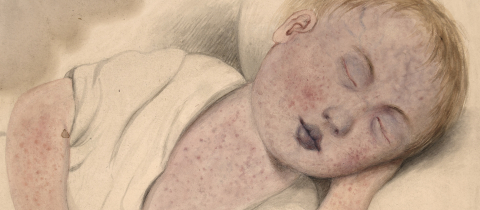Want to add a bit of extra delight to that cake or sundae? No need to bother with whisking some cream when you can just reach for that aerosol cannister of whipped cream. Just squeeze the little trigger and perfectly whipped cream gushes out! For the propellant action you can thank nitrous oxide, also known as “laughing gas.” That term was coined by the great English chemist Humphry Davy upon noting that “this gas raised my pulse upwards of twenty strokes, made me dance about the laboratory as a madman, and has kept my spirits in a glow ever since.”
Nitrous oxide can be liquified under pressure and introduced into the cannister where it readily dissolves in the cream. When the container is opened to the air, the internal pressure is reduced and the liquid nitrous oxide vaporizes, forming bubbles that convert the cream into a foam. Presto, we have a mountain of instant whipped cream! Were you to whip air by hand into the same amount of cream, you would get roughly half the volume. On the other hand, you would not have to worry about contributing to global warming or destruction of the ozone layer, concerns that arise with the release of nitrous oxide.
Nitrous oxide is a “greenhouse gas,” meaning that when present in the atmosphere it traps heat that rises from the earth. It has roughly 300 times the “warming power” of carbon dioxide but of course much less of it is emitted than carbon dioxide which makes up about 82% of emissions. Methane makes up 10% and nitrous oxide about 6%. The chlorofluorocarbons (CFCs) and other halogenated gases contribute about 3%, but the main problem with these is that aside from their role in global warming they are a major force in the destruction of the ozone layer that protects us from excessive exposure to ultraviolet light. Nitrous oxide can also destroy ozone, however, its role is much smaller than that of the halogenated compounds.
Before anyone is tempted to whip up a frenzy about eliminating nitrous oxide from whipped cream because of its global warming and ozone destruction effects, it should be understood that the amount of the gas released from whipped cream is essentially a flea on an elephant. That elephant is the nitrous oxide released naturally by plants and by fertilizers, whether natural or synthetic. Livestock manure, besides releasing huge amounts of methane, also releases nitrous oxide as bacterial enzymes decompose nitrogen containing compounds. The same goes for ammonium nitrate, urea, and ammonia, the main synthetic fertilizers that provide the nitrogen needed by crops. Not all fertilizer is taken up by plants and residues that remain in the soil or are washed into water systems also are a source of nitrous oxide due to encounter with bacteria.
Nitrous oxide is also produced when the heat of an automobile engine promotes the reaction of oxygen and nitrogen in the air to form various oxides of nitrogen. Some rocket engines also use nitrous oxide to provide extra oxygen needed for the combustion of fuel and nitrous oxide is also added to the fuel in drag racing. In both cases some unreacted nitrous oxide is released.
Nitrous oxide has also been used as an anesthetic for over a hundred years in surgery as well as dentistry. Some inevitably escapes in the patient’s exhaled breath, and while this isn’t a huge contributor to the amount in the atmosphere, it does represent a risk to physicians and dentists in the absence of proper ventilation. Exposure to nitrous oxide can impact mental performance, manual dexterity, and in extreme cases, cause neurological damage. That brings us to the problem of abuse. While small doses of nitrous oxide produce sedation and perhaps a touch of giddiness, larger doses can produce euphoria and hallucinations, sensations that are the drivers of abuse.
Laughing gas parties were a part of the social scene in late nineteenth century England but were limited to the upper classes who could avail themselves of the gas. Unfortunately, such is not the case today because nitrous oxide is easily obtained. While the law forbids the recreational use of the gas, it is available for medical purposes and for use as a food additive in whipped cream and aerosol cooking oil. There are no restrictions on the sale of nitrous oxide for culinary use and cylinders and cartridges that contain pressurized nitrous oxide can be readily purchased. Far more nitrous oxide is sold than can be accounted for by all the whipped cream being squirted onto pastries and sundaes in bakeries and home kitchens.
The evidence of abuse is clear from the numerous nitrous oxide cannisters scattered all over the grounds after raves and from the sale of balloons filled with the gas at concerts. These balloons are not decorations. What is the risk of inhaling their contents? For the occasional experimenter probably not much. But occasional experimentation can quickly rev up to regular and heavier use. That’s when neurological problems such as tingling, numbness, weakness of limbs, lack of balance, and impaired cognition can set in. This is due to nitrous oxide inactivating vitamin B12 which is essentials for the proper maintenance of myelin, the insulating layer around nerves. If this layer is disturbed, the electrical impulses that travel down nerves and are responsible for proper transmission of messages are slowed down. Some abusers of nitrous oxide are aware of this and take vitamin B12 supplements although a study by a group of New Zealand physicians did not find that such supplementation prevents neurological damage.
While there are obviously real concerns about the environmental effects of nitrous oxide in the atmosphere and about its recreational use, as far as aerosol whipped cream goes, I would worry more about the fat content than the nitrous oxide that is released.







